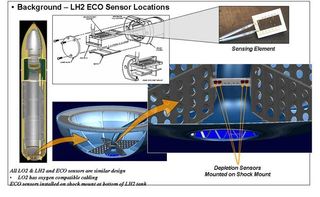NASA: No Launch for Shuttle Discovery Before July 26

CAPECANAVERAL, Fla. - NASA is working feverishly to launch the shuttle Discovery beforethe end of the month, even as engineers struggle to identify and fix a fuelsensor anomaly that scrubbed the orbiter's attempted space shot last week,mission managers said Monday.
"We'restill looking for the problem," NASA's shuttle program manager Bill Parsonssaid during an evening press conference. "This team is trying everything it canto launch in the July window."
Discoverywill not launch any earlier than July 26, which is the first opportunityengineers will have to fill its external tank with the super-chilled liquidhydrogen and liquid oxygen propellant used during liftoff, shuttle officialssaid. But whether shuttle engineers will try and launch day, or simply fill theexternal tank with fuel to check its performance, is undecided, they added.
"Hopefully,in the next 24 to 48 hours we will find the glitch that's got us all confused,"said Wayne Hale, deputy shuttle program manager, during the briefing. "But Ithink Tuesday [July 26] is probably the earliest we'd be looking for launcheven in that optimistic case."
Discovery'sSTS-114 commander Eileen Collins and her STS-114 astronaut crew will leave KSCthis week and return to NASA's Johnson Space Center (JSC) in Houston, Texas fora day of ascent and reentry training, but they should return the same days oncethe exercise is completed, NASA officials said.
The STS-114mission is NASA's first attempt at shuttle flight since the 2003 Columbiadisaster, and was poised to launch on July 13 when flight controllers received anerrant signal from an engine cut-off sensor (ECO) during a standard countdowntest.
Launch officialsscrubbed the launch attempt after the sensor, one of four liquid hydrogen fuel gauges,failed to respond accurately to a test signal from launch control. Undercurrent flight rules, all four hydrogen sensors - and four others that trackliquid oxygen levels - must perform perfectly in order to launch.
Get the Space.com Newsletter
Breaking space news, the latest updates on rocket launches, skywatching events and more!
For nearlya week, shuttle engineers have struggled and failed to identify exactly whatwent wrong with the fuel sensor system to cause the errant signal. On Sunday,they attached an external tank simulator to the sensor box aboard Discoveryresponsible for processing the external tank fuel gauge information to see ifit performed as expected, and still found nothing out of the ordinary, shuttleofficials said. Earlier today, engineers checked to make sure there were noloose wires in the orbiter's sensor system, they added.
"Our goalis to figure out a path to go find the problem and then obviously try tocorrect the problem," said Ed Mango, deputy director of orbiter projects atJSC, in the briefing.
Shuttlemanagers are considering a few approaches leading up to July 26, including afull blown fueling test of the Discovery's external tank, a less extreme testfolded into a launch countdown and a flight rule change that would set launchrequirements to need only three of the four fuel gauge sensors to operatenominally in order to lift off, NASA officials said.
Before the1986 Challenger accident, only three of the four sensors were required toperform properly, but the rule was changed when engineers realized that a powerfailure in the system could cripple two sensors at once, shuttle officialssaid. During the preparation of Discovery, that sensor power system has been modifiedto prevent such a failure, they added.
Missionmanagers at KSC and JSC studying whether to extend Discovery's STS-114 launchwindow into early August, though the much-sought after lighting conditions tophotograph the shuttle's external tank separation gradually worsen after theJuly 31 deadline. But caution, especially given the risk of human spaceflight,is paramount, they said.
"A few daysdelay to figure out what is going on and make sure we're safe is always theright answer," Hale said. "It is a business where you have to have patience."
- Fixing NASA: Complete Coverage of Space Shuttle Return to Flight
Join our Space Forums to keep talking space on the latest missions, night sky and more! And if you have a news tip, correction or comment, let us know at: community@space.com.

Tariq is the Editor-in-Chief of Space.com and joined the team in 2001, first as an intern and staff writer, and later as an editor. He covers human spaceflight, exploration and space science, as well as skywatching and entertainment. He became Space.com's Managing Editor in 2009 and Editor-in-Chief in 2019. Before joining Space.com, Tariq was a staff reporter for The Los Angeles Times covering education and city beats in La Habra, Fullerton and Huntington Beach. In October 2022, Tariq received the Harry Kolcum Award for excellence in space reporting from the National Space Club Florida Committee. He is also an Eagle Scout (yes, he has the Space Exploration merit badge) and went to Space Camp four times as a kid and a fifth time as an adult. He has journalism degrees from the University of Southern California and New York University. You can find Tariq at Space.com and as the co-host to the This Week In Space podcast with space historian Rod Pyle on the TWiT network. To see his latest project, you can follow Tariq on Twitter @tariqjmalik.
